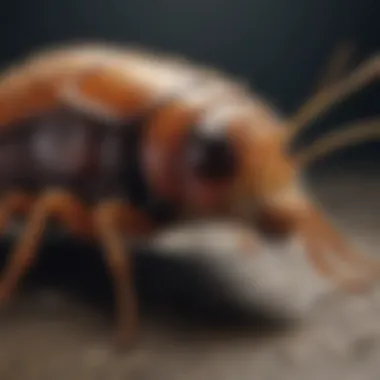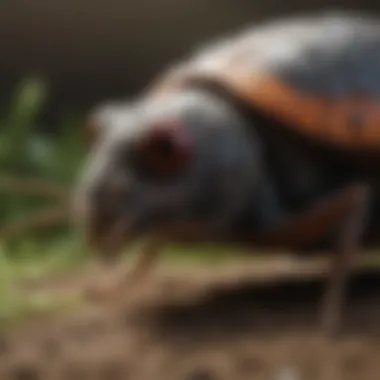Certified Pest Management Strategies in Hawaii


Intro
Hawaii, with its tropical climate and diverse ecosystems, presents unique challenges when it comes to pest management. The conditions allow for a variety of pest species to thrive, making certified pest management essential for homeowners and property managers. Understanding the intricacies of pest identification, prevention strategies, and treatment options is crucial. This article aims to provide in-depth insights that cater specifically to the needs of houses and home environments across the islands.
Pest Identification
Identifying pests accurately is the first step in effective management. Knowing the common pests in Hawaii is essential for any homeowner.
Detailed Descriptions of Common Pests
- Termites: These insects can cause severe structural damage. They primarily feed on wood and are often found in damp areas.
- Rodents: Mice and rats are not just nuisances but can also carry diseases. Their presence is usually indicated by droppings and gnawed materials.
- Ants: Various ant species, such as the sugar ant and the fire ant, often invade homes in search of food. They can be seen trailing along surfaces.
- Cockroaches: These resilient insects thrive in warm areas. Their droppings, odor, and skin shed are clear signs of an infestation.
- Mosquitoes: These pests are not only annoying but also transmit diseases. Standing water often indicates their breeding grounds.
Signs and Symptoms of Infestations
Identifying a pest problem early can save money and prevent further complications. Common signs include:
- Unusual holes or gnaw marks on wood or furniture (indicative of termites and rodents)
- Trails of ants along walls and countertops
- Presence of insect droppings or skin shedding (for cockroaches and other insects)
- Buzzing or humming sounds, especially at night (often related to mosquitoes)
"Early detection of pest issues can significantly impact management efforts and costs."
Prevention Strategies
Preventing infestations is essential for maintaining a pest-free environment. Homeowners can take several proactive measures.
Home Maintenance Tips for Pest Prevention
- Seal Entry Points: Ensure all cracks, gaps, and openings are sealed to prevent pests from entering. Pay special attention to windows and doors.
- Regular Cleaning: Keeping surfaces clean minimizes food sources for pests. Vacuum regularly and wipe down countertops.
- Manage Landscaping: Trim vegetation close to the house and eliminate standing water.
- Storage Solutions: Keep food items in sealed containers and store waste in tightly closed bins.
Natural Deterrents and Barriers
Using natural substances can also help to deter pests. Some effective options include:
- Peppermint Oil: This is a known repellent for spiders and ants.
- Diatomaceous Earth: This powder can be sprinkled in affected areas to combat pests like cockroaches and ants.
Treatment Options
When prevention methods fail, understanding treatment options is crucial to manage pest infestations effectively.
Overview of Chemical vs. Natural Treatments
- Chemical Treatments: Often labeled as pesticides, these can be effective but must be used carefully. Choose products that are approved for residential use in Hawaii.
- Natural Treatments: Many homeowners prefer these for safety and eco-friendliness. Options such as essential oils and soap sprays can be effective against common pests.
Step-by-Step Guides for DIY Treatments
For those who prefer to handle infestations independently, here are some simple DIY solutions:
- For Ants: Mix equal parts of vinegar and water. Spray it on ant trails and entry points.
- For Cockroaches: Create a mixture of baking soda and sugar. Place it in areas where roaches are seen; the roaches are attracted to sugar but poisoned by baking soda.
By understanding pest management thoroughly, homeowners in Hawaii can effectively maintain their environments and safeguard their properties from pest invasions.
Prelude to Pest Management in Hawaii
Pest management in Hawaii is a crucial topic for homeowners and residents. Given the state’s unique environment and diverse ecosystem, understanding effective pest management strategies becomes vital. Pests here include not only common household nuisances but also invasive species that pose significant threats to local flora and fauna.
The warm, tropical climate of Hawaii fosters an ideal breeding ground for various pests. This presents unique challenges and necessitates specific strategies to combat these issues. Familiarity with both certified pest management practices and local regulations is essential for residents who want to maintain a safe and healthy living environment.
There are distinct benefits to implementing certified pest management. One primary advantage is that certified pest control operators follow established guidelines and standards. This can lead to more effective treatments while minimizing potential harm to the environment and residents’ health. Additionally, certified professionals often engage in ongoing education, thereby keeping abreast of the latest trends and techniques in pest management.
Key Considerations
- Native ecosystem impact: Understanding how certain pest management methods affect native species is important.
- Regulatory compliance: Following state guidelines helps avoid potential fines and ensures safer practices.
- Customized approach: Certified pest management providers are more likely to tailor treatments to the specific challenges of Hawaii’s environment.
In summary, the effective management of pests in Hawaii is significant not only for comfort but also for environmental health. Knowing how to navigate this domain leads to better outcomes for both homeowners and the ecosystem.
Understanding Certified Pest Management
Certified pest management is a crucial topic for homeowners, especially in a unique ecological environment like Hawaii. Understanding this subject allows residents to navigate the complex landscape of pest control more effectively. It informs them about the guidelines and standards that pest management professionals must adhere to, ensuring that their methods are both safe and effective. The importance of certified pest management lies not only in dealing with existing pest problems but also in proactive planning to prevent infestations.


This section will detail the certification process, its implications for pest management practices, and how it enhances public safety and environmental protection.
Definition of Certification
Certification in pest management refers to the formal recognition by a regulatory body that a pest control professional has met specific educational and practical standards. This process often requires passing examinations and completing training programs that are tailored to local conditions, including the types of pests prevalent in Hawaii. Certification assures homeowners that the pest management services they are hiring utilize best practices that comply with state laws and environmental regulations.
Such qualifications can involve knowledge of biology, ecology, and behavior of various pests, as well as familiarity with the legalities surrounding pest management. A certified pest manager demonstrates a commitment to effective pest control strategies while minimizing risks to humans, pets, and the environment.
Importance of Certification in Hawaii
The certification of pest management professionals is particularly important in Hawaii due to the state's distinct environmental conditions. Hawaii houses a unique array of flora and fauna, making it susceptible to various pests that can disrupt local ecosystems. Therefore, employing certified pest management ensures that control methods used are appropriate for the specific challenges presented by the islands' ecosystem.
Some key reasons why certification is essential in Hawaii include:
- Environmental Impact: Certified professionals are trained to use methods that minimize harm to non-target species, including native wildlife.
- Legal Compliance: Understanding state regulations helps prevent illegal pesticide usage, protecting both home and environment.
- Enhanced Safety: Certification incorporates knowledge of safe pesticide handling, reducing risks to families and pets from harmful substances.
- Trust and Credibility: Homeowners are more likely to trust certified professionals, knowing they have met rigorous standards.
"Certification is not just a credential; it's a commitment to sustainable and safe pest management practices."
By prioritizing certified pest management, Hawaii's residents are better equipped to protect their homes from pests while preserving the unique beauty of their island environment.
Common Pests in Hawaii
Understanding the common pests found in Hawaii is essential for effective pest management strategies. The unique geography and climate of the islands create an environment that is inviting to various pests. Identifying these pests early can prevent significant damage to properties and minimize health risks. This section provides insights into the most prevalent pests in Hawaii. Homeowners should prioritize knowledge about these pests for better prevention and control methods.
Termites: A Persistent Threat
Termites are one of the most significant threats to property in Hawaii. The moist tropical climate fosters ideal conditions for these wood-destroying insects. Subterranean termites, notably the Eastern and Formosan varieties, are particularly destructive. They can cause severe structural damage to homes if left unchecked. Regular inspections are vital to detect termite activity early. Homeowners should consider preventive treatments, like bait systems or liquid barrier applications. These measures can protect homes from costly repairs and safety hazards associated with termite infestation.
Key points in termite management include:
- Routine Inspections: Check for mud tubes and damaged wood regularly.
- Moisture Control: Leaky pipes or improper drainage can attract termites.
- Barrier Treatments: Consider chemical treatments to deter termite infestations.
"Proactive measures are essential in managing termite populations effectively."
Rodents and Other Wildlife
Rodents such as rats and mice are common nuisances in Hawaii. Their presence not only causes property damage but also poses health risks through contamination of food supplies. The black rat and Norway rat are particularly notorious for invading homes. They are skilled climbers and can access attics and roofs easily. Keeping food stored securely and sealing entry points can help manage rodent problems. Homeowners should also be aware of other wildlife, like mongooses, which may disrupt gardens or gardens by hunting small animals.
Effective rodent control methods include:
- Sealing Entry Points: Fill holes and gaps in walls, doors, and foundations.
- Proper Waste Management: Store trash securely and clean up food spills quickly.
- Trapping and Baiting: Use traps in strategic locations to reduce rodent populations.
Invasive Insect Species
Hawaii is home to various invasive insect species that disrupt the native ecosystem and can affect residential areas. Pests like the coconut rhinoceros beetle and the little fire ant are problematic. The coconut rhinoceros beetle damages palm trees, while the little fire ant can create discomfort for both humans and pets. Understanding these invasive species helps in developing effective control measures.
Homeowners can take several actions:
- Education: Stay informed about new invasive pests in the area.
- Reporting: If invasive species are found, notify local pest management services or authorities.
- Prevention: Implement practices that discourage pests, such as landscaping choices that do not attract them.
In summary, awareness and understanding of common pests in Hawaii are crucial. Timely intervention and preventive measures can protect properties and preserve the health of residents.
Certificate Providers in Hawaii
The role of certificate providers in Hawaii's pest management ecosystem cannot be undervalued. These providers give life to the framework of pest control by ensuring services offered meet stringent regulations and standards, customized to the state's unique environment. Homeowners, renters, and professionals choosing to engage with certified pest management service providers can encounter numerous benefits.
Certified providers adhere to specific state regulations that optimize pest management practices. They conduct regular trainings and certifications for professionals in the field to maintain high standards, which ultimately fosters trust and efficacy in pest control operations. This trust is essential, given the diverse range of pests in Hawaii, which require specialized approaches tailored to local conditions.
State Regulations and Standards
Hawaii has strict regulations implemented to safeguard both the environment and public health. The state's Department of Agriculture outlines guidelines that pest control companies must follow. These regulations ensure safe application of pest control methods, reducing any potential harm to native species and ecosystems.
Key points include:
- Licensing Requirements: Pest control professionals must obtain and renew licenses through the state. This includes passing examinations that cover local pests, pest management techniques, and the safe handling of chemical agents.
- Safety Guidelines: Regulations require all certified companies to follow safety protocols that protect both the public and the environment. This includes proper training for personnel in the safe application of treatments.
By adhering to these standards, homeowners can have peace of mind that the pest management services they receive are not only effective but also environmentally responsible.
Notable Pest Control Organizations


Several organizations in Hawaii play a crucial role in maintaining high standards in pest management. These organizations offer certifications, ongoing training, and resources for professionals in the industry.
Some notable pest control providers include:
- Hawaiian Pest Control: Known for its comprehensive services and commitment to environmentally friendly practices, this organization educates clients on integrated pest management strategies.
- Aloha Pest Control: This company focuses on family-safe pest solutions while maintaining high standards of training among its employees.
- Terminix Hawaii: A well-established name, offering a range of pest control solutions while emphasizing compliance with local laws and regulations.
"Timely and effective pest management is not just about exterminating pests; it is about creating a sustainable environment for future generations."
These organizations contribute to a cohesive system of certified pest management in Hawaii, ensuring that pest control agents are equipped with the necessary knowledge and tools. Their efforts can lead to a beneficial impact, reducing pest invasions while protecting the islands' unique biodiversity.
Preventive Measures for Homeowners
Preventive measures are vital in maintaining a pest-free environment in Hawaii. The unique climate and ecosystem of the islands create conducive conditions for various pests. Thus, taking proactive steps is essential for homeowners. Effective prevention can help minimize pest invasions, reduce the need for chemical treatments, and enhance the overall living experience.
Building and Maintenance Techniques
Homeowners should consider several building and maintenance techniques to prevent pest issues. Firstly, ensuring proper sealing of all cracks and crevices around doors, windows, and the foundation can greatly reduce entry points for pests. Use weather stripping to mitigate gaps. Additionally, maintaining a well-organized garden is crucial; keep mulch away from home foundations and ensure that vegetation is trimmed back to reduce hiding spots.
Regular maintenance of roofs and gutters is also essential. Clogged gutters can trap moisture, attracting pests like termites and rodents. Inspect and repair any leaks promptly. These measures not only protect against infestations but also preserve the structural integrity of the home.
Monitoring and Inspection Practices
Monitoring and inspection are key components of effective pest prevention. Homeowners should conduct regular inspections of their property for signs of pest activity. This can include droppings, gnaw marks, or nests. Setting up periodic inspections, especially in areas most prone to pest activity, such as basements, attics, and crawl spaces, can help catch problems early.
It is also beneficial to engage in community awareness programs or local pest control workshops. Staying informed about the pests common in Hawaii and emerging trends in pest management can empower homeowners to act swiftly. Utilizing integrated pest management (IPM) concepts can guide homeowners in identifying and addressing pest issues without relying solely on chemical treatments. This holistic approach contributes to a healthier home environment while promoting sustainability.
"An ounce of prevention is worth a pound of cure"; this old adage stands true when it comes to pest management. Regular monitoring and proactive measures turn out to be effective strategies for hassle-free living.
Effective Treatment Options
In the realm of certified pest management in Hawaii, the importance of effective treatment options cannot be overstated. Hawaii’s unique ecosystem demands tailored approaches, ensuring that pest control measures are not only effective but also environmentally sound. Homeowners face a variety of challenges, from common household pests to more severe infestations, necessitating a well-rounded understanding of available treatment strategies. This section will delve into two primary categories: chemical solutions and natural remedies. Each has its benefits and considerations, providing homeowners with options to combat pests effectively while keeping safety and environmental impact in mind.
Chemical Solutions
Chemical solutions remain a staple in pest management for their efficacy in quickly dealing with infestations. These products typically fall into categories such as insecticides, herbicides, and fungicides, each targeting specific pests or problems. Homeowners should consider several factors when choosing chemical treatments:
- Target Specificity: Many chemical solutions are designed to target particular pests, minimizing collateral damage to non-target species.
- Speed of Action: Chemical treatments often provide rapid results, which is crucial during severe infestations.
- Ease of Application: Many commercially available products come ready to use, simplifying application.
However, there are important considerations:
- Safety Precautions: Proper handling is essential to avoid harm to humans and pets. Always read the label carefully and follow all instructions.
- Environmental Impact: Some chemicals can be harmful to non-target organisms and may persist in the environment, leading to potential negative consequences.
- Resistance Management: Over-reliance on a single chemical can lead to resistance in pest populations, rendering products less effective over time.
Before proceeding with chemical solutions, conducting a thorough inspection and correctly identifying the pest is crucial for effective management.
"Using the right chemical solution is not just about getting rid of pests; it's about doing so responsibly and effectively."
Homeowners should work closely with certified pest management professionals to select the best and safest chemical options for their specific situation.
Natural Remedies and Alternatives
For those seeking less conventional approaches, natural remedies and alternatives have gained popularity in recent years. These options are often perceived as safer for both people and the environment. Common natural treatments include:
- Diatomaceous Earth: This natural powder can be effective against insect pests. It works by damaging the exoskeletons of insects.
- Essential Oils: Certain essential oils, like peppermint or neem oil, have repellent properties and can disrupt insect hormone systems.
- Biological Control: Introducing natural predators or parasites of pests, such as ladybugs for aphids, can be an efficient and sustainable control strategy.
Considerations for using natural remedies include:
- Effectiveness: While some natural solutions can be effective, they may take longer to show results compared to chemical treatments.
- Application Techniques: Many natural remedies require repeated applications and precise application techniques for efficacy.
- Research and Evidence: Limited scientific data may exist on some natural alternatives, making it essential to rely on trusted sources and advice from professionals.
Homeowners looking for a pest management strategy that aligns with environmental values may find natural remedies appealing. Combining both chemical and natural methods can also yield effective results, specially when tailored to the specific pest problem at hand.
The Role of Education in Pest Management
Education plays a vital role in pest management strategies, especially in a unique environment like Hawaii. The islands' diverse climate and ecosystems create distinct challenges that require specific knowledge and practices. Without education, both professionals and the general public may struggle to identify, prevent, and address pest issues effectively. Educational initiatives can bridge this gap and foster a collaborative approach to management efforts.
Moreover, informed homeowners are better equipped to maintain their properties, reducing the need for frequent pest control interventions. Understanding the lifecycle of pests or the signs of infestations can lead to early detection. This proactive stance benefits both the environment and homeowners' wallets by minimizing costly treatments and potential property damage.
Training for Pest Control Professionals
Professional training is essential for those operating within Hawaii's pest management sector. Certified pest control technicians must stay abreast of current best practices, regulations, and emerging pest threats unique to the islands. Training programs may include topics such as integrated pest management (IPM), the biology of local pests, and safe application techniques for various control methods.


Ongoing education is necessary as it allows professionals to adapt to changes in pest behavior and resistance. Industry certifications, such as those offered by the Hawaii Department of Agriculture, assure that technicians possess the knowledge to utilize effective and environmentally responsible practices. This is particularly important considering Hawaii's delicate ecosystems.
"Without proper training, pest control efforts may not only fail but also cause harm to the local environment."
Community Awareness Programs
Community awareness programs serve to educate the public about pest management. These programs can take many forms, like workshops, informational pamphlets, and social media campaigns. They aim to communicate the importance of pest management beyond individual households. By fostering a community-wide understanding, these initiatives empower residents to participate actively in prevention measures.
Topics covered in community programs might include:
- The health risks associated with specific pests.
- Best practices for maintaining a pest-free home, such as proper waste management and habitat modification.
- The significance of reporting infestations to professionals.
Effective community programs contribute to a cultural shift towards more responsible pest management practices. When communities mobilize and collaborate, it enhances the overall effectiveness of pest management efforts across Hawaii.
Addressing Myths in Pest Control
In the realm of pest management, a clear understanding often becomes clouded by misconceptions and myths. Having accurate information is crucial for homeowners and pest control professionals alike. Addressing these myths is an integral aspect of pest management in Hawaii. It has the potential to reshape perceptions, enhance strategies, and ultimately foster a more effective approach to pest control.
First, dispelling myths helps homeowners make informed decisions. Many individuals might believe that all pests are harmful or that pest control is only necessary during certain seasons. In reality, pests can invade at any time of the year, and not all of them pose threats to health or property. Understanding this can alleviate unnecessary fears and direct focus on prevention strategies.
Moreover, knowledge reduces reliance on harmful practices. Some may think that using more chemicals guarantees a better outcome. However, this can lead to unsafe environments for both families and wildlife. Emphasizing safe and effective methods encourages sustainable practices and lessens the impact on the delicate Hawaiian ecosystem.
Additionally, a clear understanding of pest behavior is fundamental. Many people assume that once a pest is eradicated, it will not return. This overlooks the importance of ongoing maintenance and monitoring. By dispelling such beliefs, homeowners can adopt a proactive approach rather than a reactive one, which ultimately leads to more successful long-term pest management.
Common Misconceptions Debunked
Many misconceptions persist about pest control which requires clarity.
- Pest Control is Only for Serious Infestations: Many homeowners believe that pest control measures are only necessary when facing a severe infestation. Scheduled inspections and preventative treatments can help mitigate pest populations before they become a problem.
- Only Chemicals Work: There is often a prevailing opinion that chemical treatments are the sole solution to pest problems. In fact, there are multiple non-toxic alternatives and integration of natural remedies that can be effective without adverse side effects.
- All Pests are Dangerous: This misunderstanding can lead to unnecessary panic or extreme measures. Not all pests cause damage or pose risks to health. For instance, some insects play important roles in the ecosystem.
"Understanding pest behavior and implementing preventative measures can significantly reduce the likelihood of infestations."
- DIY Methods Are Always Effective: While some DIY methods may provide temporary relief, they often do not address the underlying issues. Professional pest control services are trained to diagnose and treat issues comprehensively.
- Once a Pest is Gone, It Won't Come Back: Lastly, many mistakenly believe that eradicating a pest leads to complete freedom from that issue. In fact, pests can return if preventive measures are not maintained.
By addressing these common misconceptions, we equip homeowners with knowledge that enhances their ability to manage pest issues effectively. Clear information leads to better decision-making and long-term solutions for pest management in Hawaii. It also aligns with the state's commitment to environmental stewardship and sustainable practices.
Future Trends in Pest Management
The landscape of pest management is evolving rapidly. In Hawaii, the unique biodiversity and environmental conditions necessitate that pest control strategies adapt to current trends. This section highlights upcoming trends that are redefining certified pest management, focusing on the critical elements that impact effectiveness, sustainability, and homeowner protection.
Technological Advances
One of the most significant shifts in pest management involves technology integration. Modern methods utilize data analysis and smart technology to enhance pest detection and treatment. For example, the use of drones and remote sensors enables pest control professionals to survey properties efficiently. These tools gather data on pest activity patterns, allowing for targeted interventions.
Moreover, mobile apps are becoming increasingly popular among pest management professionals. These apps assist in tracking pest sightings, scheduling treatments, and educating homeowners about effective prevention strategies. By automating data collection and analysis, pest management becomes more streamlined and effective.
Another notable innovation is the refinement of smart traps. These traps can notify homeowners when pests are detected, ensuring rapid response. This reactive approach minimizes pest populations before they establish residence, reducing the need for extensive chemical treatments. The integration of AI in these devices allows for predictive analysis, ultimately leading to more effective management strategies.
"A proactive approach to pest management, using technology, ensures better outcomes for homeowners and the environment alike."
Sustainable Practices
Sustainability plays a pivotal role in future pest management trends. In Hawaii, where the ecosystem is delicate, the adoption of environmentally friendly practices is essential. One promising trend is the increased use of integrated pest management (IPM). This method combines biological control, cultural practices, and chemical applications in a balanced way, reducing environmental impacts. IPM emphasizes prevention and monitoring, allowing for timely interventions without resorting to harsh chemicals.
Another emerging trend is the use of eco-friendly pest control methods. Products that leverage natural ingredients are gaining popularity. These may include plant-based insecticides or microbial solutions that target specific pests without harming beneficial insects or the environment. Homeowners are encouraged to explore these alternatives as they provide effective control while maintaining ecological integrity.
Additionally, education is crucial in promoting sustainable practices. Homeowners should be informed about environmentally safe options and how they can contribute to pest management in their homes. This includes simple actions like maintaining gardens and proper waste disposal, which can deter pests. Creating awareness around the importance of sustainability will empower homeowners to make informed decisions.
In summary, both technological advances and sustainable practices are at the forefront of future trends in pest management. These practices not only enhance the effectiveness of treatments but also ensure that Hawaii’s unique environment is preserved for future generations.
Culmination
In examining certified pest management in Hawaii, we uncover a multifaceted approach to safeguarding homes and health. The challenges presented by Hawaii's unique ecosystem necessitate specialized techniques and certifications that ensure pest control professionals are well-trained and effective in their methods.
The importance of certification cannot be overstated. It serves not just as a quality assurance mechanism but also as an indicator of a service provider’s commitment to environmentally responsible practices. For homeowners and renters alike, discernment in choosing a certified pest management provider can lead to effective pest solutions and ultimately, peace of mind.
The insights gleaned from this discourse have broad implications for evaluating current pest management strategies. Understanding the linkage between certification and effective pest control can influence decision-making processes at both the individual and community levels. It encourages a proactive stance against common pests in Hawaii, while also advocating for preventive measures that can dramatically reduce infestations.
Moreover, this exploration highlights the necessity of continuous education within the industry, ensuring that practitioners stay abreast of evolving methodologies and technologies. As new pest challenges arise, adapting to these change is crucial for maintaining optimal living conditions.
"A well-informed homeowner is an empowered homeowner."
Summary of Key Points
- Certification Matters: It guarantees that pest management professionals are trained and adhere to strict standards.
- Unique Ecosystem Challenges: Hawaii's environment requires tailored pest management strategies to address specific local pests.
- Preventive Measures: Homeowners can implement various strategies to minimize pest encounters from the outset.
- Continuous Education: Ongoing training equips pest control experts with the latest knowledge and techniques, improving outcomes.
- Community Awareness: Promoting understanding about pest management helps to foster resilient, pest-free communities.



